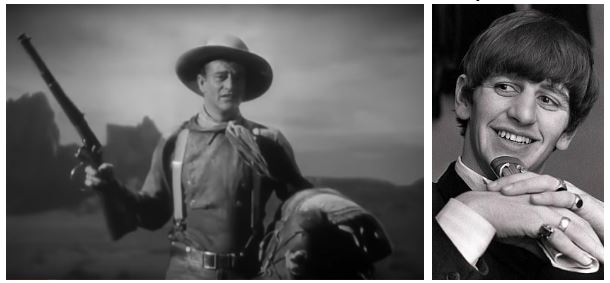 Having previously discussed the thumb, the index finger, and the middle finger, I turn to the ring finger, which the Romans called digitus anularis, from anulus, the diminutive form of anus, a ring. The modern English spelling of annulus with two n’s was a mediaeval error.
Having previously discussed the thumb, the index finger, and the middle finger, I turn to the ring finger, which the Romans called digitus anularis, from anulus, the diminutive form of anus, a ring. The modern English spelling of annulus with two n’s was a mediaeval error.
A Roman anulus was a finger ring, such as a signet ring, and by extension a badge of a senator or an eques, a member of the equestrian order, one with property enough to be able to provide his own horse. It also meant chain mail made out of rings and a ringlet of hair.
In his Naturalis Historia (Book XXXVII), Pliny recounted the myth that the habit of wearing rings on the fingers started with Prometheus. After Herakles had freed him from enchainment on the rock to which Zeus had consigned him, as a punishment for giving mankind the gift of fire, Prometheus wore a ring forged from his chains attached to a fragment of the rock, symbolically reminding him that he was still in thrall to Zeus.
King Polycrates of Samos, Pliny also tells us, hoping to avert punishment by the goddess Fortuna for his prosperity and unremitting happiness, threw a valuable ring into the sea. A fish swallowed it, was caught, and served to the King. The return of the ring symbolized the fact that one cannot escape one’s fate.
In another version of this tale, Herodotus tells how the fish was served to King Solomon, whose wisdom was supposed to derive from the ring, which reputedly gave him the power to speak to animals. Konrad Lorenz’s 1949 book about animal psychology was originally titled “Er redete mit dem Vieh, den Vogeln und den Fischen” (he spoke to the beasts, birds, and fishes), and was translated into English with the title “King Solomon’s Ring”.
Rings need not be worn on the ring finger. Thumb rings were commonly worn by archers, to protect the ball of the thumb from chafing by the bow. They were also popular during the 16th century as symbols of wealth or authority. The first recorded instance in English is in Henry IV Part I (II.v.334). Prince Harry ribs Sir John Oldcastle, fictionally the forerunner of Falstaff, calling him “lean Jack” and “bare-bone”, and asking him when he last saw his own knee. Oldcastle protests that when he was Hal’s age “I could have crept into any Alderman’s thumb ring”, but that sighing and grief “blows a man up like a bladder”. When naming a cardinal, the Pope places a ring on the recipient’s thumb. As the successor of the first Pope, Saint Peter, the Pope himself wear a ring, the Fisherman’s Ring or anulus piscatoris, on the ring finger of his right hand. When the Pope dies, the ring is broken and a new ring is cast.
In mediaeval times rings that were worn by kings, starting with Edward the Confessor (St Edward’s ring), or blessed by them on Good Friday, were thought to have healing properties. A cramp-ring, for example, was thought to be effective against cramps and epilepsy. The Romans also called the ring finger digitus medicinalis, because, as the unreliable Isidore of Seville explained in his Etymologiae (XI.i.70), doctors used it to stir eye ointments.
The surnames Ring and Ringer imply that someone in your family was once a ring maker or a bell ringer. The Ringo kid in John Ford’s classic western Stagecoach (1939; picture) was the breakthrough part that lifted John Wayne out of the milieu of B movies. But in the 1937 short story on which the movie was based, Stage to Lordsburg by Ernest Haycox, the kid’s name is Malpais Bill. The name “Ringo” goes back in Western lore to Johnny Ringo, a gunslinger who had a famous showdown with Doc Holliday in Tombstone in January 1882. In July of that year, Ringo was found dead in Arizona with a gun in his hand and a bullet wound in his temple. The coroner brought in a verdict of suicide, but murder theories abound, possible culprits including Wyatt Earp and Doc Holliday. Ringo Starr, on the other hand, was so-called because of his habit of wearing rings, typically two on each hand (picture).

The perfect circle made by a ring symbolizes eternity, nowhere more so than in the wedding ring. In the Jewish marriage ceremony the groom places the ring on his bride’s right index finger. The habit of wearing wedding rings on the ring finger of the left hand came from the belief that a blood vessel led from there to the heart by the shortest route.
A woman proudly shows her friends her new wedding ring, with its enormous gem, the Psmith Diamond. But, she reveals, it comes with a curse. What curse? they ask. Mr Psmith!
Jeffrey Aronson is a clinical pharmacologist, working in the Centre for Evidence Based Medicine in Oxford’s Nuffield Department of Primary Care Health Sciences. He is also president emeritus of the British Pharmacological Society.
Competing interests: None declared.
